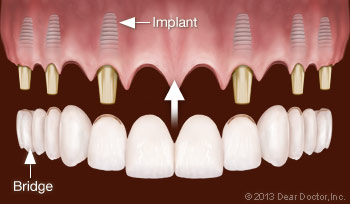Replacing a full set of teeth using multiple sectional implant supported bridges has been around for many years. It is an appealing option as it gives you the most natural way to replace teeth with good ability to keep them clean and the loss of one implant does not affect the overall outcome as much as other available options. However, it is extremely technique sensitive and takes longer than other options. It also needs a good foundation to achieve desirable outcomes.
In technical terms, we call this a FP1 or FP2 Implant Supported Bridges which means the bridges (or prosthesis) mainly replace missing teeth. The gums and the bone are regenerated using advanced surgical regenerative techniques.
This is a relatively advanced procedure that is performed only by a few dental offices in Canada as requires very high precision. It also depends on the foundation already available. It is usually only an option when you already have teeth that will be extracted and replaced with implants immediately.
You will walk out of the office with a full set of temporary teeth so you will never be without teeth. The temporary prosthesis will allow healing of the bone and the gums and also allow you and our team to test drive the bite, fit, shade, speech, etc. We will switch over the temporaries in 3-6 months to the permanent ones which should last you a long time if you maintain it.
Dr. Novin has been performing this procedure since 2016 successfully and is specially trained in this. The following is a case performed at our office.




Process:
- Pre-surgical assessment:
- Clinical examination and consultation with one of our dentists.
- Records: 3D scans, impressions and photos.
- Pre-prosthetic Phase:
- You will meet with one of our dentists who will determine the best option for your temporary prosthesis.
- Surgical Phase:
- Extracting any existing teeth that are determined to be remove and contouring/regenerating the lost bone and gum.
- Installation of a minimum of 8 implants as per the pre-determined plan using digital scans and radiographs.
- Installation of temporary prosthetic parts.
- Recovery Phase:
- Radiographs, examinations and adjustments as necessary over the next 3-6 months to ensure properly healing.
- Prosthetic Phase:
- Replacing temporary bridges with a permanent zirconia based bridges that will last a very long time.
Advantages:
- Highly esthetic option if performed properly.
- Ability to plan with one section and as you lose more teeth, more sections are added.
- Easy to keep clean – patient is able to brush and floss normally and no special oral hygiene methods are required.
- Loss of one implant does not compromise the whole case and can be replaced individually or as a part of the sectional bridge.
- Evenly distributed forces just like a natural set of teeth.
- In 10-15 years or when you start to lose bone as part of aging or due to the lack of oral hygiene, we can still remove the implants and go to Full Mouth Implant supported hybrid bridge.
Disadvantages:
- Most expensive option to replace a full set of teeth.
- Requires extensive planning.
- Requires regular oral hygiene appointments with one of our hygienists.
- Flossing and/or powered is necessary to keep the implants clean.
- Not recommended when the smile line is low and patient shows a lot of gums when smiling or laughing.
Maintenance
- You will need to come to the office at least four times a year to have a cleaning done by the hygienist and regular radiographs and checkups are necessary as with a natural set of teeth.

